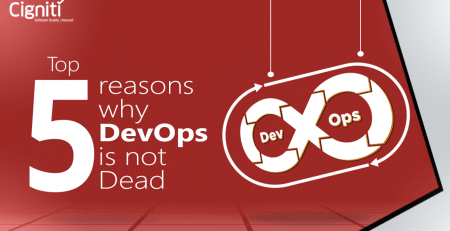10 Best Practices for Successful DevOps Implementation
The increasing adoption of DevOps by most organizations across the globe indicates its potential as a key enabler to achieving scale. Implementing DevOps practices helps an organization deliver faster, better, high-quality, and reliable software, relying on the culture of cooperation and collaboration among all functions of an organization.
It calls for fundamental cultural changes and modification of legacy programming practices. Here are the core DevOps best practices that help an organization achieve the goals of effective communication and collaboration, smoother operations, and bug-free code.
Ten Key Recommendations for Successful DevOps Implementation
Here are the ten key recommendations for successful DevOps implementation:
1) Evaluate the need to implement DevOps practice
Align your IT goals with Business goals. The need for implementation of DevOps should be business-driven. It should not be implemented just because it is the latest trend, but your development process for the business goals should demand this change.
2) Break the organizational silos & encourage collaboration
DevOps practices demand a breakdown of functional silos among various disciplines in IT. The philosophy of DevOps essentially is that development, operations, and other functions must work closely by cooperating and collaborating among themselves.
Breaking down organizational silos improves communication among the teams enabling accessibility to information to everyone about what was done in the past, the people involved, and the associated results. It helps with better decision making and, in turn, fetches better output and better ideas.
3) Put Customer / end-user satisfaction at the center
Organizations must adapt to the ever-changing customer demand and deliver services/solutions that exceed customer expectations regarding time, functionality, and performance.
This is possible only by embracing the change in culture that stresses team effort, transparent communications, and commitment to customer satisfaction, etc. DevOps will not be successful without the support of all the key business stakeholders.
Right from defining the requirements, prototype development, unit/integration/regression testing to deployment, everyone should be involved.
4) Don’t jump start; instead, start small and then scale up
Achieve the DevOps implementation approach for faster and smaller release cycles and then adopt it at scale. Some quick successes consolidate the belief of various stakeholders in the new approach.
Moving the IT culture away from silos needs trust and acceptance in the new philosophy. Also, organizations need to upskill current talent rather than hire from outside. It enables existing employees to achieve early success, which helps improve their confidence in adopting DevOps.
5) Automate wherever possible
Automation enables faster execution throughout the SDLC, keeping up with the speed of DevOps. Automation can be employed and extended to code development, middleware configuration, database and networking changes, and essential testing, including regression testing and load testing. Automation saves the time and effort of developers, testers, and operations personnel and, in turn, total costs.
6) Select tools that are compatible with each other
The automation tools used in DevOps should be chosen depending on how they react with another tool. It is recommended that you choose a toolset that is compatible with your IT environment. Ensure that you adopt tools that are suitable to the existing toolchain.
Tooling decisions should be made wisely, considering the overall compatibility of the tool for your organization. It is usually effective if the tools you choose are from a single vendor because they must have been closely integrated. Careful selection of tools reduces the conflicts that they possibly create between development and operations.
7) Define performance reviews for a team and an individual
When the IT culture demands collaboration, it requires an evaluation of the team’s and individual’s performance in the team. Since cooperation and collaboration are at the core of DevOps implementation strategy, performance reviews for developers and operations personnel should mostly be based on their teams’ ability to meet their development and deployment goals.
8) Ensure real-time visibility into the project
For a cross-functional IT organization, it is important to have project management tools that provide real-time visibility into a project or an application is required. It makes the project coordination among different functions easier.
All the stakeholders need to understand in which phase the project is in the development phase to the deployment process. Advanced project management tools have built-in automation that eases getting the information by displaying who and what are the crucial resources for the project’s current tasks.
9) Integrate and deliver continuously
Embracing DevOps implementation without Continuous Integration and Continuous Delivery will be inefficient and unsuccessful. Continuous integration is one of the key components of agile processes, and it enables developers to develop software in small, regular steps by immediately detecting defects and providing feedback.
Continuous delivery is an extension of continuous integration. The Continuous Delivery approach ensures that every new or revised requirement is rapidly and safely deployed to production with quality by delivering every change to a production-like environment and ensuring that the software/application functions as intended through rigorous test automation.
It confirms that the software functions as intended through rigorous automated testing. Hence, Continuous Integration and Continuous Delivery should not be neglected for successful DevOps implementation.
10) Achieve better results with monitoring & feedback
Continuous monitoring is essential to know if the software or application performs as desired while the environment is unwavering. The Operations team must ensure that the applications are performing at the optimal levels. They may work with the development team to build monitoring and analytics capabilities into the developed applications.
Finally, DevOps is a set of principles and practices that facilitates an organization in making their delivery of software/applications lean and efficient while leveraging feedback from end-users that helps continuously improve. The feedback mechanism improves the processes of delivering an application.
DevOps is not just an initiative but an expedition to continuously improve an organization’s practices and culture to offer better value and satisfaction to customers and achieve improved business outcomes.
Contact us If you want to learn more about DevOps and wish to embrace DevOps practices and principles. Our Agile and DevOps Advisory & Transformation services are focused on helping clients identify key areas of improvement, benchmark and align their Agile / DevOps processes to industry best practices, design target operating models to maximize the investments, and provide recommendations and roadmap to adopt Agile & DevOps practices and establish a high maturity Agile DevOps Organization.





Comment (1)
While I am very enthusiastic about DevOps and its potential. Continuous delivery does not work in all domains. It is a very poor model for healthcare. Tragically so.